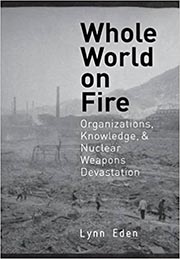Whole World on Fire: Organizations, Knowledge, and Nuclear Weapons Devastation
by Lynn Eden
Reviewed August 26, 2005
 Lynn Eden's "Whole World on Fire" is a well written and carefully documented book that examines the devastating firestorms, or more accurately "mass fires," that would follow a nuclear explosion and why this consequence was largely ignored by nuclear war planners.
Lynn Eden's "Whole World on Fire" is a well written and carefully documented book that examines the devastating firestorms, or more accurately "mass fires," that would follow a nuclear explosion and why this consequence was largely ignored by nuclear war planners.
Eden, associate director of research at the Center for International Security and Cooperation of the Institute for International Studies at Stanford University, gives the reader an account of the devastation that a single 300 kiloton weapon would create if detonated over the Pentagon, near Washington D.C. Such an attack would produce an area of "approximately 45-60 square miles...(that) would be engulfed in a mass fire." She describes an environment where the "average air temperature would exceed the boiling point of water, and winds would be of hurricane force."
So with such tremendous effects that far exceed those from the blast forces, why did the U.S. war planners not factor them into their targeting and weapons requirements?
This is the heart of the book. Starting before World War II, military planners focused on the strategy of precision bombing and the blast effects necessary to destroy a specific target. Eden traces this mindset through the early years of the atomic age, as planners ignored the massive damage produced by the fires at Hiroshima and Nagasaki and remained focused on the atomic bomb's blast effects.
There were attempts at modeling the possible extent of damage produced by the fires, but uncertainty and organizational resistance into this area slowed understanding of this component of nuclear warfare.
One of the principle investigators in to the thermal effects is Harold Brode. Through most of his career, he has been pushing for better modeling and revision into the damage tables that war planners use in developing their targeting requirements.
Personally, I was drawn into the study of nuclear weapons by the threat of multiple mass fires producing an effect known as "nuclear winter." It is disturbing to learn that so little is truly known about the true extent of the consequences of a nuclear explosion over a city.
This book provides the reader with a great insight into how well-funded and highly professional organizations can produce incomplete or incorrect analyses by focusing on what they do well. Implications of this organization failure can have dramatic results, such as the sinking of Titanic or the O-ring failure of the space shuttle Challenger. This book is a must read for anyone interested in the development of nuclear policy and organization structures. Available at amazon.com